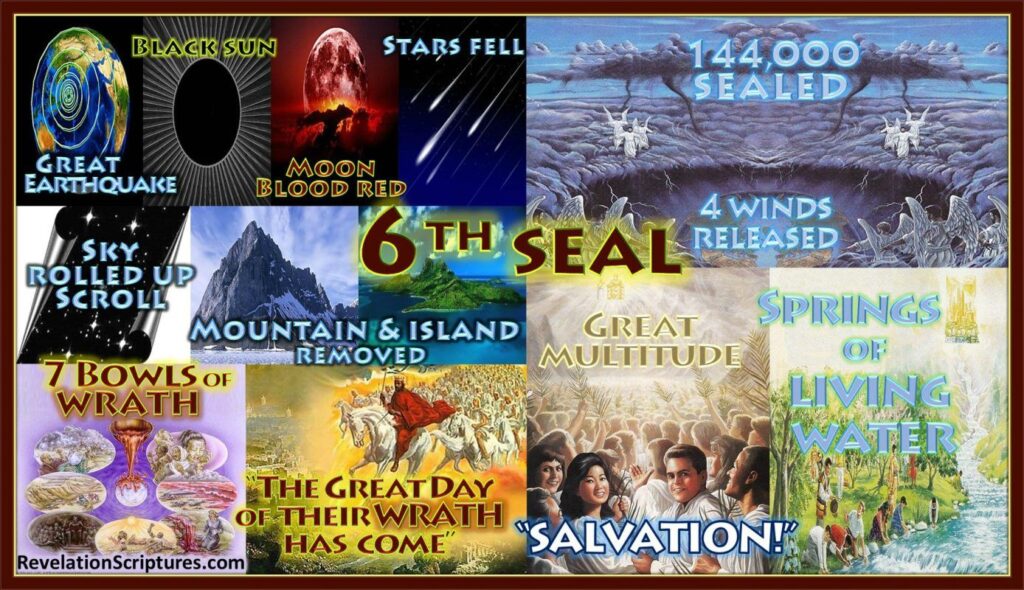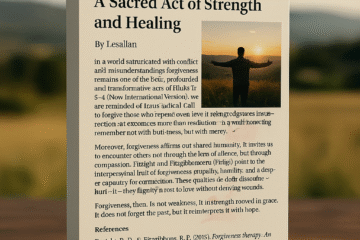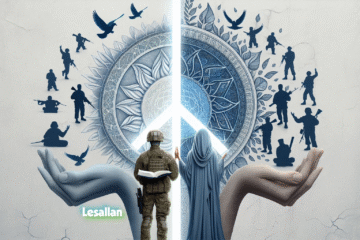Written by Lesallan Bostron
BIB3560 Revelation (ONLSP23)
Ohio Christian University
Pastor Alexander Soultz
April 25, 2023

Detailed Analysis: Revelation Chapter 6 (ESV)
Initial Observations & Questions
- The sixth chapter in the Book of Revelation is divided into four sections: the first four seals (Revelation 6:1-8, ESV), the fifth seal (Revelation 6:9-11, ESV), and the sixth seal (Revelation 6:12-17, ESV).
- The four horsemen are introduced with the first four seals (Revelation 6:1-8, ESV), each a different color and symbolizing various aspects of God’s wrath.
- What is the significance of each color?
- How do these four horsemen symbolize God’s wrath?
- Revealed in the fifth seal (Revelation 6:9-11, ESV) are the souls of the martyrs, those that have met death for their faith in God and their testimony, crying out for justice, given white robes, and told to wait until their number is complete.
- Who are these martyrs who have met death because of their faith and testimony?
- The sixth seal causes cosmic disturbances and natural disasters (Revelation 6:12-14, ESV).
- What are these natural disasters?
- What are these disaster signs of?
- The interlude to chapter seven begins in chapter seven itself, after the opening of the sixth seal in Revelation 6:12 (ESV).
Structure
Revelation chapter six describes the events that will occur when the Lamb (Jesus Christ) has opened the first six seals of the scroll containing God’s plan for the end times (Revelation 6, ESV). These events are part of the tribulation period (seven years), which will be a time of great suffering and judgment for unbelievers on the earth. The events in the sixth chapter of Revelation are related to the end of the age Jesus predicted in Matthew 24:4-31. The four horsemen unleash war, famine, death, and persecution by opening the first four seals (Revelation 6:1-8, ESV). Revealed in the fifth seal are the martyrs who cry out for God’s justice, are given white robes, and are told to hold on longer (Revelation 6:9-11, ESV). The sixth seal causes great earthquakes, cosmic disturbances, and fear among the people trying to hide from God’s wrath (Revelation 6:12-16, ESV). The seventh seal is opened in chapter eight (Revelation 8:1, ESV), introducing seven trumpets of judgment (Revelation 8:2, ESV). What is shown to the reader of Revelation chapter six is that God is in control of history and will judge the wicked and vindicate His people in His own time and way. A warning is given of the terrible things and the consequences of rejecting God’s grace and mercy given and offered through Jesus Christ.
Revelation chapter six has a chiastic structure that consists of two main divisions. The structure can be outlined by the opening of the first seal: a white horse with a conquering rider (Revelation 6:1-2, ESV); the second seal is opened: a red horse with a rider who takes peace from the earth (Revelation 6:3-4, ESV); the third seal is opened: a black horse with a rider who brings famine and economic distress (Revelation 6:5-6, ESV); the fourth seal is opened: a pale horse with Death upon its back and Hades who kills a fourth of the earth (Revelation 6:7-8, ESV); the fifth seal is opened: the souls of the martyrs under the altar who cry out for God’s justice (Revelation 6:9-11, ESV); with the opening of the sixth seal comes cosmic disturbances that cause terror and panic on the earth (Revelation 6:12-17, ESV). The next chapter of Revelation brings the interlude: the sealing of 144,000, from Israel (God’s children) who are protected from God’s wrath on earth (Revelation 7:9-17, ESV). The two main divisions are the opening of the first six seals (Revelation 6:1-17, ESV) and the interlude between the sixth and seventh seals (Revelation chapter 7, ESV).
- The first seal is opened: revealing a white horse and its rider with a bow and a crown, symbolizing conquest (Revelation 6:1-2, ESV).
- The second seal is opened: revealing a red horse and its rider with a sword, symbolizing war and bloodshed (Revelation 6:3-4, ESV).
- The third seal has opened: a black horse and its rider with a pair of scales, symbolizing famine and economic distress, is revealed (Revelation 6:5-6, ESV).
- The fourth seal has opened: a pale horse and its rider named Death, followed by Hades, symbolizing death by various means (Revelation 6:7-8, ESV).
- The fifth seal is the martyrs’ souls under the altar, crying out for God’s justice and receiving white robes (Revelation 6:9-11, ESV).
- The sixth seal is opened: cosmic disturbances and natural disasters are revealed, causing terror and panic among the people of the earth (Revelation 6:12-17, ESV).
Words & Phrases
“a white horse” (Revelation 6:2, ESV)
What does the phrase “a white horse” mean or symbolize?
In Revelation 6:2 (ESV), “a white horse” symbolizes conquest and domination. The first of four horsemen who bring forth judgment on the earth when the Lamb (Jesus Christ) opens the first of four seals of the scrolls that contains God’s plan for the end of times.
What type of imagery is associated with “a white horse” in the immediate context of the passage (Revelation 6:2, ESV), and what does it represent?
The rider on the white horse has a bow, a weapon of war and aggression, and a crown, a symbol of authority and victory. White represents purity and righteousness; however, it may be deceptive and false. The rider may claim to be a peacemaker and savior, but the rider is a tyrant and an oppressor. The white horse and the rider represent the rise of a political and military power that will dominate the world during the tribulation period. Many interpreters have identified this with the Antichrist, who appears as a charismatic leader but is deceptive with many of his signs and wonders. Again, he will persecute and kill those who do not worship him or his image (Daniel 9:27; 2 Thessalonians 2:3-12; Revelation 13:1-18).
“Another horse, bright red” (Revelation 6:4, ESV)
What does “Another horse, bright red” mean or symbolize?
The phrase “Another horse, bright red” (Revelation 6:4, ESV) means or symbolizes war and bloodshed. It is the second of four horsemen who bring judgment on the earth as the Lamb (Jesus Christ) opens the second (Revelation 6:3, ESV) of the first four seals of the scroll containing God’s plans for the end of times.
What kind of power has been given to the rider on the red horse (Revelation 6:4, ESV)?
The rider on the red horse is given the power to take peace from the earth and to make people kill each other (Revelation 6:4, ESV).
What imagery is associated with “Another horse, bright red” and the rider (Revelation 6:4, ESV)?
The rider was given a great sword, an image associated with being a weapon of war and violence. In addition, red (color) is often associated with blood and death in the Bible (Isaiah 63:1-3; Revelation 14:20; Revelation 19:13).
“A black horse” (Revelation 6:5, ESV)
What does the phrase “A black horse” (Revelation 6:5, ESV) mean or symbolize?
The phrase “A black horse” (Revelation 6:5, ESV) means or symbolizes famine and scarcity. This is the third of four horsemen who bring judgment on the earth when the Lamb (Jesus Christ) opens the third of the first four seals containing God’s plan for the end of times.
What type of imagery is associated with the “rider” on the “black horse” (Revelation 6:5, ESV)?
The rider carries a pair of scales to weigh food in times of shortage and rationing. The color black suggests that there will be starvation and death as food becomes scarce and expensive (Revelation 6:5-6, ESV).
“A quart of wheat for a denarius, and three quarts of barley for a denarius, and do not harm the oil and wine!” (Revelation 6:6, ESV)
What does the statement “A quart . . . oil and wine!” mean or symbolize?
The phrase “A quart . . . oil and wine!” (Revelation 6:6, ESV) means or symbolizes the prices and conditions of food during a time of famine and scarcity. It is part of the announcement made by a voice amid the four living creatures (Revelation 6:6, ESV) when the Lamb (Jesus Christ) opens the third seal (Revelation 6:5, ESV) of the scroll that contains God’s plan for the end times. “A quart of wheat or three quarts of barley,” the voice declares, will cost a denarius equivalent to a laborer’s wages. This cost of a denarius means that food would be costly and scarce and that people would have to spend all their income to buy enough food for themselves, let alone a family. The voice says that oil and wine are not to be harmed; these items were luxury items, implying that the rich will still enjoy their wealth while the poor suffer from hunger. This statement may also represent God’s blessings and grace that is not entirely withdrawn from the earth, even during judgment. This statement symbolizes the contrast between the necessities and superfluities of life and the severity of God’s wrath on the earth (Revelation 6:6, ESV).
“A pale horse” (Revelation 6:8, ESV)
What is the meaning or what is symbolized by the phrase “A pale horse” (Revelation 6:8, ESV)?
“A pale horse” in Revelation 6:8 (ESV) symbolizes death and the grave. This is the fourth of the four horsemen who bring judgments on the earth when the Lamb (Jesus Christ) opens the first four seals of the scroll that contains God’s plan for the end of times.
What do the pale horse and its rider represent in Revelation 6:8 (ESV)?
What is represented in Revelation 6:8 (ESV) is widespread mortality and destruction resulting from the wars, famines, and plagues unleashed in the previous three openings of the seals (Revelation 6:2-6, ESV). These deaths will affect a large number of people and will cause many souls to enter Hades, where humanity’s final judgment is awaited (Revelation 20:11-15, ESV).
“the souls” (Revelation 6:9, ESV)
What does “the souls” (Revelation 6:9, ESV) refer to?
The term “the souls” in Revelation 6:9 (ESV) refers to the immaterial and immortal part of human beings that survives after death. This term comes after the opening of the fifth seal. When the phrase “the souls” is used in the context of the entire verse, these are the souls of those who have been killed (martyred) for their faith in God and their testimony of Jesus Christ.
What does the vision found in Revelation 6:9 (ESV) symbolize?
The souls are seen under the altar, which may symbolize their sacrificial death or connection to the heavenly temple (Revelation 6:9, ESV). Nevertheless, they are alive, crying out to the Lord but waiting for God’s justice and vengeance on their enemies (Revelation 6:10, ESV).
Summary, correlation, & application
The main point of Revelation chapter six is to reveal the events that will occur when the Lamb (Jesus Christ) opens the first six seals of the scroll that contains God’s plan for the end of times (Revelation 6:1-17, ESV).
This central point is seen by observing that the events are part of the tribulation period. This period of tribulation is a seven-year time of great suffering and judgment for unbelievers on the earth. The sixth chapter of Revelation shows that God is in control of history and will be the judge of the wicked and the vindicator of His people in His own time and way. This chapter of Revelation also warns us of the terrible consequences of rejecting God’s grace and mercy offered through Jesus Christ. Further observation shows that the Lamb (Jesus Christ) is the only one who can open the scroll that contains God’s plans for the end times (Revelation 5:1-14, ESV). As the Lamb (Jesus Christ) opens, the first six seals unleashed are a series of judgments on the earth that directly relate to the signs of the age that Jesus predicted in Matthew 24:4-31. These judgments include war, famine, death, persecution, cosmic disturbances, and terror (Revelation 6:1-17, ESV). The opening of the fifth seal reveals the souls of those slain for the word of God and their witness. They are alive and crying out for God’s justice, given white robes and told to wait until their number is complete (Revelation 6:9-11, ESV). There is then an interlude between the opening of the sixth and seventh seals, which provides a contrast between the wrath of God on the earth and the protection of God for His people in heaven and on earth (Revelation 6:12 – 7:1-8, ESV). Revelation chapter six ends with a rhetorical question, “Who can stand?” (Revelation 6:17, ESV). Implied is that no one can stand before God’s wrath unless they have received His grace and mercy through Jesus Christ. Meant is that those who stand with Christ will overcome the world and inherit eternal life.
Jesus the Lamb, the one opening the seals, identified as the Lion of the tribe of Judah, the Root of David, who has conquered (Revelation 5:5-7, ESV), is referenced in the messianic prophecies found in Genesis 49:9-10 and Isaiah 11:1-10. The messianic prophecies foretell that a descendant of Judah and David would rule over the nations and bring peace and justice to the earth. The four living creatures who call out “come!” when each seal is opened are similar to the cherubim or seraphim described in Ezekiel 1:4-28 and Isaiah 6:1-7. The red horse and rider taking peace from the earth and making people kill one another (Revelation 6:4, ESV) echo the words of Jesus in Matthew 24:6-7, where a warning is given to the disciples that wars and rumors of wars will be among the signs of the end times. The black horse and rider bring famine and economic distress (Revelation 6:5-6, ESV) like those that occurred in Egypt (Genesis 41:53-57), Israel (1 Kings 17:1-16), and other places in Biblical history. Jesus has also said in Matthew 24:7 that famines will be among the birth pains of the last days. In Revelation 6:8, the pale horse, and its rider whose name is Death, and Hades who follows him may allude to the personification of death and the underworld in passages such as Psalm 49:14-15, Isaiah 25:8, Hosea 13:14, and 1 Corinthians 15:54-55. Jesus also made a statement in Matthew 24:7 that pestilence will be another sign of the end times. Those souls that have been slain for God’s word and their witness under the altar (Revelation 6:9-11, ESV) remind us of others in Biblical history. Martyrs who have suffered for their faith in God throughout history include Abel (Genesis 4:8-10), Stephen (Acts 7:54-60), James (Acts 12:1-2), and others. Jesus, in His words found in Matthew 24:9, says that His followers will be persecuted and killed for His name’s sake in the last days. The sixth seal opens with cosmic disturbances in Revelation 6:12-14 (ESV), corresponding to the prophetic visions of Joel 2:30-31, Isaiah 13:9-13, and Ezekiel 32:7-8, describing the day of the Lord as a time of great upheaval and terror for the wicked. Jesus has said in Matthew 24:29 that after the tribulation, the sun will be darkened, the moon will not give its light, and the stars will fall from heaven. The reaction of the kings and people who hid from the face of Him who is seated on the throne, secreted away from the wrath of the Lamb in Revelation 6:15-17 (ESV), parallel the response of Adam and Eve who hid from God after they sinned (Genesis 3:8), the reaction of Israel who trembled at God’s presence on Mount Sinai (Exodus 19:16-19). Jesus’ words in Matthew 24:30 state that all tribes of the earth will mourn when they see Him coming on the clouds of heaven with power and great glory.
This sixth chapter of Revelation reminds me that Jesus Christ is the Lamb who was slain and worthy of all worship and praise. He is the One that holds the scroll of God’s plan for the end of times and He who is worthy and opens the seals that unleash God’s judgments on the earth. Jesus, the Lamb, is the one who protects and rewards His faithful people in heaven and on earth. Therefore, all people should trust and worship Him with all their heart, soul, mind, and strength. The challenge is to be faithful and courageous in witnessing Christ and His gospel in an evil and hostile world. Shown is that there will always be persecution and suffering for those who follow Christ and His word; however, there will also be comfort and reward for those who endure to the end of time and the end of days. God will avenge the blood of His martyrs, judge the wicked and destroy His enemies. Therefore, fear not those who can kill the body but cannot kill the soul; rather, fear Him who can destroy both soul and body in hell (Matthew 10:28). Shown is that I, as well as churches, should be watchful and ready for His coming, that I should be involved in His mission to make disciples of all nations (Matthew 24:42-44; Matthew 28:18-20). It urges me to pray for God’s kingdom to come and His will to be done on earth as in heaven. Shown is God’s will to save His people from every nation and to judge His enemies with righteousness and justice. Prayer is essential, and therefore all must pray for God’s name to be hallowed, His gospel to be preached, His church to be edified, His enemies to be subdued, His creation to be restored, and His glory to be revealed (Matthew 6:9-13; Revelation 11:15).
References:
Bauer, D. R. (2014). Inductive bible study – a comprehensive guide to the practice of Hermeneutics. Baker Publishing Group.
Bauer, & Traina. (2022). How to Study Words and Phrases. In https://lms.ohiochristian.edu/d2l/home. https://lms.ohiochristian.edu/
Beale, G. K. (1999). Revelation: a commentary on the Greek text. W.B. Eerdmans.
Beasley-Murray, G. R. (1997). “Revelation, Book of.” In Dictionary of the Later New Testament and Its Developments, edited by Ralph P. Martin and Peter H. Davids, 1025–38. Downers Grove, IL: Intervarsity.
BibleProject. (2021). How to Read the Bible: Apocalyptic Literature. Www.youtube.com. https://www.youtube.com/watch?v=UNDX4tUdj1Y
Book of Revelation – ESV – Bible Study Tools. (n.d.-a). Biblestudytools.com. Retrieved April 17, 2023, from https://www.biblestudytools.com/esv/revelation/
Book of Revelation – ESV – Bible Study Tools. (n.d.-b). Biblestudytools.com. https://www.biblestudytools.com/esv/revelation/
Book of Revelation Explained Scripture by Scripture. (2023). Bible-Studys.org. https://bible-studys.org/Discoverrevelation.com/Book%20of%20Revelation%20Explained.html
G3340 – metanoeō – Strong’s Greek Lexicon (ESV). (n.d.). Blue Letter Bible. Retrieved April 24, 2023, from https://www.blueletterbible.org/lexicon/g3340/esv/mgnt/0-1/
Grey, E. (2014, July 4). Erika Grey. Prophecy Talk. https://erikagrey.com/short-summary-of-the-book-of-revelation/
Insight for Living Ministries. (2009, June 4). Reading Revelation. Www.insight.org. https://www.insight.org/resources/article-library/individual/reading-revelation
Keener, C. S. (2014). The IVP Bible background commentary: New Testament. Intervarsity Press.
Koester, C. R., & Coffman, K. P. (2023, January). Summary of Revelation. Enter the Bible. https://enterthebible.org/courses/revelation/lessons/summary-of-revelation
LaHaye, T. (2010). Revelation Unveiled. Zondervan.
Logan, C. (2019). English Standard Version – Read Online. Bible Study Tools. https://www.biblestudytools.com/esv/
Mounce, R. H. (1997). The Book of Revelation. W.B. Eerdmans.
Pena, A. (2018, April 18). 5 important things to know about the Book of Revelation. Www.christiantoday.com. https://www.christiantoday.com/article/5-important-things-to-know-about-the-book-of-revelation/128526.htm
Revelation 2 – ESV Bible – Bible Study Tools. (n.d.). Biblestudytools.com. Retrieved April 24, 2023, from https://www.biblestudytools.com/esv/revelation/2.html
Revelation 2:1-7 ESV – – Bible Gateway. (2016). Www.biblegateway.com. https://www.biblegateway.com/passage/?search=Revelation%202:1-7&version=ESV
REVELATION KJV. (1611). Www.kingjamesbibleonline.org. https://www.kingjamesbibleonline.org/Revelation
Seedbed. (2014). Where Did Rapture Theology Come From? Ben Witherington III. In YouTube. https://www.youtube.com/watch?v=d_cVXdr8mVs
Smith, J. (2019). Revelation Summary. Biblehub.com. https://biblehub.com/summary/revelation/1.htm
The Book of Revelation. (n.d.). Www.cliffsnotes.com. https://www.cliffsnotes.com/literature/n/new-testament-of-the-bible/summary-and-analysis/the-book-of-revelation
TheLastDialogue. (2019, February 24). Book of Revelation Summary. The Last Dialogue. https://www.thelastdialogue.org/book-of-revelation-summary/
Walton, J. H., Victor Harold Matthews, & Mark William Chavalas. (2000). The IVP Bible background commentary Old Testament. Downers Grove, Ill. Intervarsity Press.
Witherington III, B. (2014, October 14). Ben Witherington rapture theology – Bing video. Www.bing.com. https://www.bing.com/videos/search?q=Ben+Witherington+rapture+theology&view=detail&mid=EC27B1578BC50349BF0EEC27B1578BC50349BF0E&FORM=VIRE
Witherington, B. (2015). Is the Rapture Doctrine Biblical? (Ben Witherington). Www.youtube.com. https://www.youtube.com/watch?v=cg8lRGqtMHc



